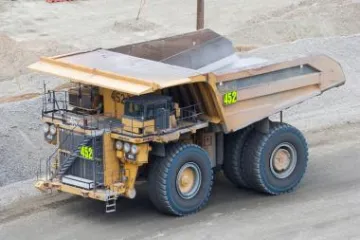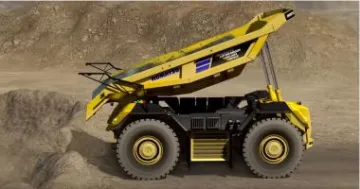Innovation in the mining industry
May 2021
In the last few decades, the hard work put into modernizing mining has fostered an industry that is now a world leader in technology. Mark Baker, Principal at CheckMark Consulting, Inc. and board member of the Lowell Institute for Mineral Resources, has been building and promoting new tech from the get-go.
Working with big names like Intel, Caterpillar, Modular Mining Systems and more, Baker witnessed an enormous amount of ‘firsts’ take place in the mining industry and has even led the charge of developing many himself.
“In those days (we’re talking circa 1979), mobile computers didn’t really exist. Radio communications and telemetry were at an infant stage. There was really no GPS for locating equipment,” Baker says. “It was all exciting, it was all new. We were breaking new ground.”

Conventional haul truck
From touch screens to interrupt driven radio networks, radio tracking beacons to data analytics, mining tech has been growing in leaps and bounds. Take optimized fleet control and automated vehicles, for instance. Caterpillar began working with autonomous hauling trucks in the 80s, but it wasn’t until Komatsu built up interest throughout the 90s that the concept even began to gain acceptance in the community.
According to Baker, most novel systems take more than ten years to catch on and spread in industrial mining settings, despite the benefits of early exploitation. The potential value of increased efficiency and reduced cost can pale in comparison to high initial prices and the inevitable risk of failed ideas.
So, researchers have been chugging away with the development of new technology, but the customers have been lagging behind. “When we developed this system, the challenge was obviously to make this technology work, which we eventually did. The second challenge was then introducing it to an industry,” Baker says.
Challenging old mindsets
Mining companies like to be what Baker calls first to be second. Because they’d rather avoid risk, they want to see somebody else work out the kinks before jumping on tech that hasn’t been proven. That way they can demonstrate that the value justifies the risk, since it’s already succeeded. There’s also a long-standing tradition of brushing aside technology in favor of methods that have already been established because that’s ‘just the way it’s done.’
“The hard part from the sales perspective is going out and convincing an industry that’s not used to having automation, to automate,” Baker says. “It was difficult trying to convince this industry that had done it the same way for many, many decades that new technology could optimize and give you actionable information.”
The public, on the other hand, has other troublesome viewpoints to overcome. “Accidents make the headlines. Everyone thinks this is a dirty, grungy, underground, dangerous environment. I’ve watched this thing evolve. Mines today are cleaner and safer than they’ve ever been,” Baker says. “The mining industry does a terrible job of getting that to the public.”
These outdated perspectives often lead to technology being adopted slowly, where only a small percentage of innovators are willing and able to risk committing to new things in exchange for a chance at the greatest benefit.
“Not everybody takes a look at it and says, ‘hey, this is great, let’s just do it.’ As you can see, it’s kind of slow to take off. You get your real low percentage of first people—risk takers—that decide this technology has promise and get involved with it early,” Baker says.
Out with the old, in with the new

Fully autonomous haul truck (computer graphics)
“Technology is not a solution. Technology enables solutions to be implemented,” Baker says. It’s not uncommon for the actual processes supporting the technology to remain unchanged. Getting the most value out of new tech requires a successful implementation plan, where the mining process undergoes a redesign to fit the upgrade.
The benefits of properly adopting new technologies are already being reported. Among them are enhanced worker safety, reduced travel costs, increased efficiency of workers and fuel, fewer delays, and less downtime due to misuse and overloading.
“The mines, eventually, will be completely automated. As artificial intelligence and these markets continue to evolve, we’re going to see more and more of that go in. It’s going to make things much more efficient,” Baker says. “Ultimately, we’ll see a completely automated mine, and it’ll be really cool.”
Related topic
Mining Innovation Finds Commercial Success through Tech Transfer

